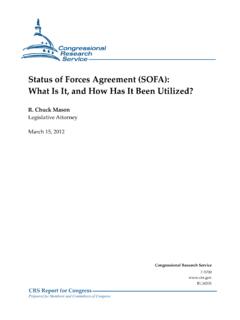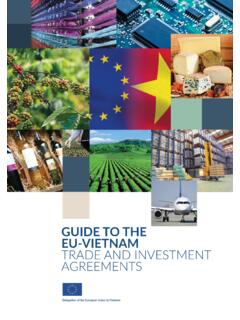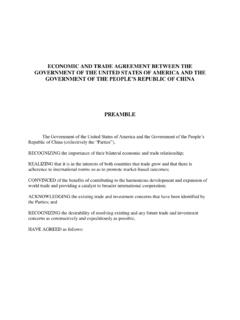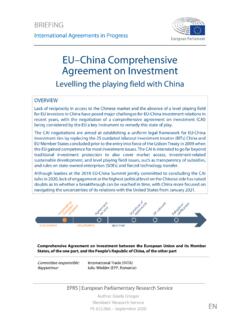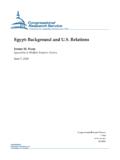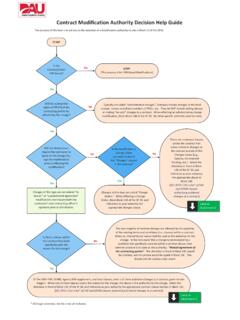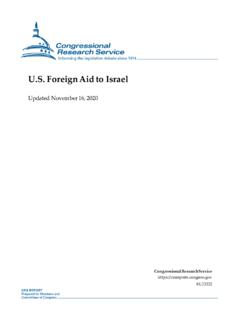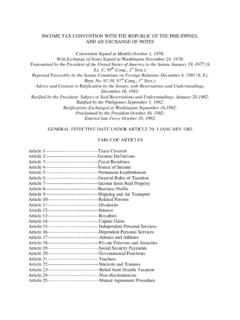Transcription of Mexico's Free Trade Agreements - FAS
1 Mexico's Free Trade Agreements M. Angeles Villarreal Specialist in International Trade and Finance April 25, 2017. Congressional Research Service 7-5700. R40784. Mexico's Free Trade Agreements Summary Mexico has had a growing commitment to Trade integration and liberalization through the formation of free Trade Agreements (FTAs) since the 1990s, and its Trade policy is among the most open in the world. Mexico's pursuit of FTAs with other countries not only provides economic benefits, but could also potentially reduce its economic dependence on the United States. The United States is, by far, Mexico's most significant trading partner. Approximately 80% of Mexico's exports go to the United States, and about 47% of Mexico's imports are supplied by the United States. In an effort to increase Trade with other countries, Mexico has a total of 11 free Trade Agreements involving 46 countries.
2 These include Agreements with most countries in the Western Hemisphere, including the United States and Canada under the North American Free Trade agreement (NAFTA), Chile, Colombia, Costa Rica, Nicaragua, Peru, Guatemala, El Salvador, and Honduras. In addition, Mexico has negotiated FTAs outside of the Western Hemisphere and entered into Agreements with Israel, Japan, and the European Union. Economic motivations are generally the major driving force for the formation of free Trade Agreements among countries, but there are other reasons countries enter into FTAs, including political and security factors. One of Mexico's primary motivations for its unilateral Trade liberalization efforts of the late 1980s and early 1990s was to improve economic conditions in the country, which policymakers hoped would lead to greater investor confidence, attract more foreign investment, and create jobs.
3 Mexico could also have other reasons for entering into FTAs, such as expanding market access and decreasing its reliance on the United States as an export market. The slow progress in multilateral Trade negotiations may also contribute to the increasing interest throughout the world in bilateral and regional free Trade Agreements under the World Trade Organization (WTO). Some countries may see smaller Trade arrangements as building blocks for multilateral Agreements . Since Mexico began liberalizing Trade in the early 1990s, its Trade with the world has risen rapidly, with exports increasing more rapidly than imports. Mexico's exports to all countries increased 515% between 1994 and 2016, from $ billion to $ billion. Although the 2009. economic downturn resulted in a decline in exports, the value of Mexican exports recovered in the years that followed. Total imports also increased rapidly, from $ billion in 1994 to $ billion in 2016, an increase of 388%.
4 The Trade balance went from a deficit of $ billion in 1994 to surpluses of $ billion and $ billion in 1995 and 1996. Since 1998, Mexico's Trade balance has remained a deficit, equaling $ billion in 2016. Mexico's top five exports in 2016. were passenger motor vehicles, motor vehicle parts, motor vehicles for the transport of goods, automatic data processing machines, and electrical apparatus for telephones. Mexico's top five imports were motor vehicle parts, refined petroleum oil products, electronic integrated circuits, electric apparatus for telephones, and automatic data processing machines. In the 115th Congress, issues of concern related to the Trade and economic relationship with Mexico may involve a possible renegotiation of the North American Free Trade agreement (NAFTA) and its effects, Mexico's external Trade policy with other countries, Mexico's intentions of moving forward with multilateral or bilateral free Trade Agreements with Asia Pacific countries, economic conditions in Mexico and the labor market, and the status of Mexican migration to the United States.
5 This report provides an overview of Mexico's free Trade Agreements , its motivations for Trade liberalization and entering into free Trade Agreements , and Trade trends with the United States and other countries in the world. Congressional Research Service Mexico's Free Trade Agreements Contents Introduction .. 1. Motivations for Trade Integration .. 1. Mexican Trade 2. Mexico's Free Trade Agreements .. 4. 4. 5. Mexico-European Union .. 5. Mexico-European Free Trade Association .. 6. Mexico-Uruguay .. 7. Mexico-Japan .. 7. Mexico-Colombia .. 8. Mexico-Israel .. 9. Mexico-Peru .. 9. Mexico-Central America .. 10. 10. Other Agreements .. 11. Proposed Trans-Pacific Partnership agreement .. 11. Pacific Alliance .. 11. Mexico-Bolivia Economic Complementation agreement .. 12. Partial Scope Agreements .. 12. Mexico's Merchandise Trade .. 14. Economic Policy Challenges for Mexico .. 16. Implications for Interests.
6 16. Figures Figure 1. Mexico's Trade 3. Figure 2. Mexico's Merchandise Trade : 15. Figure 3. Mexico's Exports and Imports by FTA Partner .. 15. Tables Table 1. Mexico's Partial Scope Agreements .. 13. Table 2. Composition of Merchandise Trade : 14. Contacts Author Contact Information .. 17. Congressional Research Service Mexico's Free Trade Agreements Introduction Regional Trade Agreements (RTAs) throughout the world have increased since the early 1990s. Many members of the World Trade Organization (WTO) are focusing on regional or bilateral free Trade Agreements as a key component of their foreign and commercial This interest is evident among industrialized and developing countries, and throughout various world regions. Mexico is a member of the WTO, which permits members to enter into regional Trade integration arrangements under certain conditions that are defined within specific WTO Since the early 1990s, Mexico has had a growing commitment to Trade liberalization and has a Trade policy that is among the most open in the world.
7 Mexico has actively pursued free Trade Agreements (FTAs) with other countries to help promote economic growth, but also to reduce its economic dependence on the United States. The United States is, by far, Mexico's most significant trading partner. Over 80% of Mexico's exports are destined for the United States. In an effort to increase Trade with other countries, Mexico has entered into 11 free Trade Agreements with 46 Mexico is a signatory to the Trans-Pacific Partnership (TPP), a proposed free Trade agreement (FTA) signed by 12 Asia-Pacific countries on February 4, 2016, after eight years of negotiation. It would require congressional ratification before it could become effective. On January 30, 2017, the United States gave notice to the other TPP signatories that it does not intend to ratify the agreement , effectively ending the ratification process and TPP's potential entry into force, unless the Administration changes its position.
8 Mexico and other TPP countries have proposed moving forward on an FTA without the participation of the United In the 115th Congress, congressional interest related to the Trade and economic relationship with Mexico may involve issues related to the North American Free Trade agreement (NAFTA) and a possible renegotiation, the effects of NAFTA, Mexico's ongoing efforts to form Trade Agreements with other countries, the status of the proposed TPP and the possibility of its moving forward without the United States, economic conditions in Mexico, Mexico's labor market, and Mexican migration to the United States. This report provides an overview of Mexico's free Trade Agreements , its motivations for Trade liberalization and entering into free Trade Agreements , Trade trends with the United States and other countries, and some of the issues Mexico faces in addressing its economic challenges.
9 This report will be updated as events warrant. Motivations for Trade Integration Economic motivations are generally the major driving force for the formation of free Trade Agreements among countries, but there are other reasons countries enter into FTAs, including political and security factors. Mexico's primary motivation for the unilateral Trade liberalization efforts of the late 1980s and early 1990s was to improve economic conditions in the country, which policymakers hoped would lead to greater investor confidence and attract more foreign investment. This motivation was a major factor in negotiating NAFTA with the United States and Canada. The permanent lowering of Trade and investment barriers and predictable Trade rules 1. See CRS In Focus IF10002, The World Trade Organization, by Ian F. Fergusson and Rachel F. Fefer. 2. For more information on the specific sets of rules governing regional Trade Agreements among WTO members, see Regional Trade Agreements : Rules on the WTO website, available at 3.
10 World Trade Organization (WTO), Regional Trade agreement Database, available at ; and Organization of American States, Foreign Trade Information System, available at 4. See CRS In Focus IF10000, TPP: Overview and Current Status, by Brock R. Williams and Ian F. Fergusson. Congressional Research Service 1. Mexico's Free Trade Agreements provided by FTAs can improve investor confidence in a country, which helps attract foreign direct investment (FDI). Multinational firms invest in countries to gain access to markets, but they also do it to lower production costs. Mexico has other motivations for continuing Trade liberalization with other countries, such as expanding market access for its exports and decreasing its reliance on the United States as an export market. By entering into Trade Agreements with other countries, Mexico is seeking to achieve economies of scale in certain sectors of the economy and to expand its export market.










